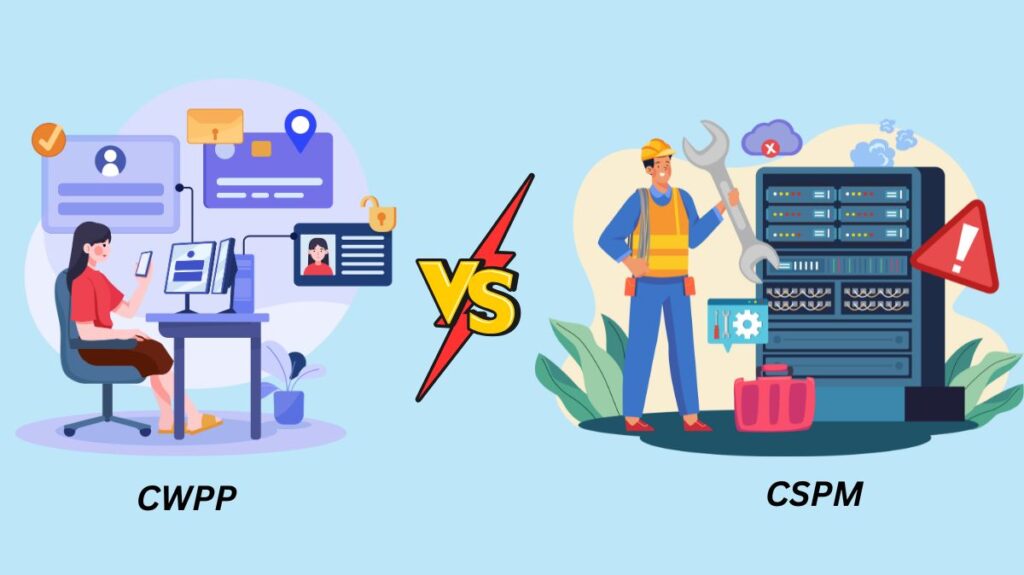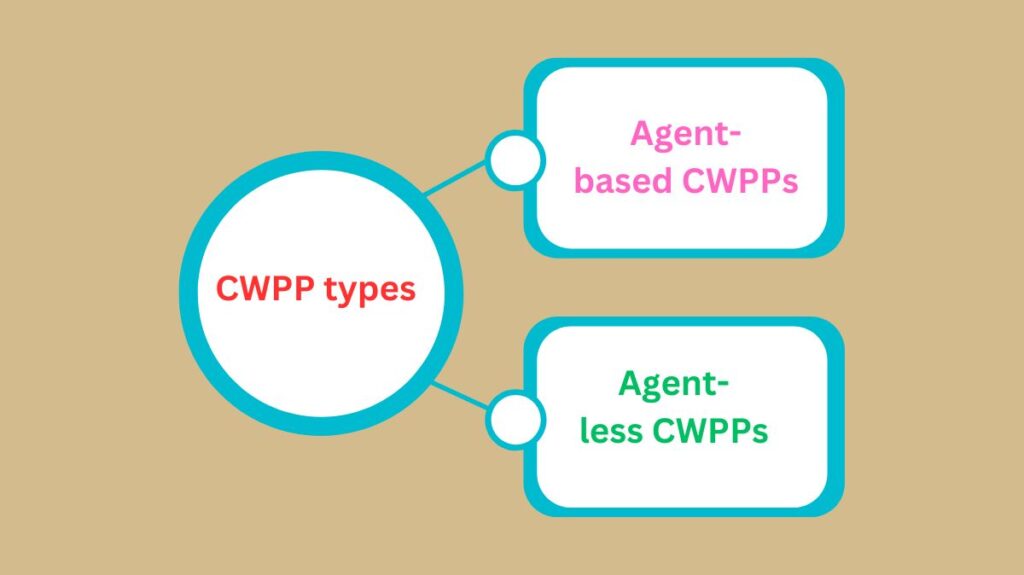CWPP Vs CSPM

| Feature | CWPP | CSPM |
|---|---|---|
| Primary Focus | Workload-centric protection for active cloud resources | Security configuration and posture management of the entire cloud environment |
| Scope | Virtual machines, containers, serverless functions, and other cloud workloads | Cloud infrastructure, including storage, databases, networking, and access controls |
| Key Functions | – Runtime security – Threat detection – Vulnerability management | – Identifying misconfigurations – Compliance monitoring – Policy enforcement |
| Objective | Protect workloads during execution and mitigate runtime threats | Ensure overall cloud infrastructure adheres to security best practices |
| Threat Coverage | Focused on active threats like malware, exploits, and runtime vulnerabilities | Identifies potential risks from misconfigurations or improper policies |
| Remediation | Mitigation actions for runtime threats, such as isolating workloads or patching vulnerabilities | Provides guidance to fix misconfigurations and improve compliance |
| Monitoring Scope | Continuous monitoring at the workload level | Continuous monitoring of security configurations across all cloud services |
| Examples of Protection | Securing Docker containers, Kubernetes clusters, and serverless functions | Fixing open storage buckets, improper IAM permissions, or unencrypted databases |
| Integration | Integrated into workload environments for runtime visibility | Integrated into cloud management tools for holistic infrastructure assessment |
| Use Cases | – Secure DevOps workflows – Protect runtime environments – Detect intrusions | – Ensure regulatory compliance – Enforce security policies – Prevent configuration drift |
Cloud Workload Protection Platform (CWPP) advantages
Because CWPP solutions are built to satisfy the security needs of both on-premises and cloud-based workloads, they provide a variety of advantages to businesses who use them to protect their apps, such as:
Agility
DevOps CI/CD pipelines may be automatically configured to safeguard apps created with workloads to Cloud Workload Protection Platform solutions. As a result, developers may include security into DevOps procedures without needlessly increasing burden.
Flexibility
The cloud’s capacity to scale resources up and down in response to demand is one of its greatest benefits. Because CWPPs are cloud-based, businesses may get the same degree of flexibility in terms of workload and application security.
Cost
When compared to physical appliances in on-premises settings, cloud solutions’ flexibility and usage-based invoicing provide for considerable cost reductions. In terms of cost reductions, CWPP is comparable to other cloud-based solutions.
Security
Because workloads are different from conventional on-premises applications, they also have particular security needs and issues. Solutions from Cloud Workload Protection Platforms make it simple for a company to implement customized security measures that offer the degree of visibility these cloud workloads need and shield them from frequent security risks.
Visibility
Because multi-cloud deployments include a range of vendor-specific environments, they can be complicated and challenging to monitor and manage. An organisation may employ network segmentation to gain a better understanding of traffic flows across its on-premises and cloud-based infrastructure and deploy a single solution across all environments with CWPP.
Compliance
In order to adequately safeguard the sensitive data in their possession, organizations must put in place specific security procedures in accordance with data protection rules. Security measures will be put in place to satisfy compliance requirements after CWPP solutions automatically search for vulnerabilities and compliance infractions that might jeopardies this protected data.
CWPP types

Some CWPP solutions may be more (or less) appropriate for the particular workflow needs of an organisation. Although all CWPPs may offer comparable security features, their methods of protection vary. Traditional agent-based CWPP and the more recent agent-less CWPP are the two primary varieties.
Agent-based CWPPs
Conventional agent-based Every cloud workload must have a software agent deployed in order to comply with CWPPs.
Agent-based CWPPs provide the following advantages:
- Comprehensive security monitoring with detailed insight into system settings, network traffic, and workloads.
- Enhanced reaction time to active attacks through real-time threat detection.
- Agents that are adaptable and may be set up to satisfy the requirements of certain workloads or task types.
Although agent-based CWPPs have certain advantages, they are also slow to implement and can cause major overhead that slows down particular workloads and platforms. Agent-based CWPPs offer workload-level security, therefore any workload that may be deployed becomes extremely susceptible due to security blind spots created by partly deployed agents.
Agent-less CWPPs
Without an agent CWPPs eliminate the need to bundle distinct workloads with their own agents by being incorporated into the cloud service provider’s API.
This approach sacrifices real-time monitoring and granular control in exchange for a number of worthwhile advantages, such as:
- Much faster deployment times.
- Complete, ongoing coverage of all cloud resources, including those that have already been produced and those that have not.
- By removing resource consumption linked to individual agents and potential compatibility issues, workload efficiency was increased and agent deployment, updates, and administration overhead was decreased.
CWPP Implementation
Configure Alerts and Monitoring
For CWPP implementation to be effective, monitoring and warning systems must be put in place. This entails configuring dashboards and technologies that provide real-time insight about workload activity and any dangers. Security teams can quickly identify and address events when they are monitored effectively.
Security staff are kept informed of odd activity by automated warnings that are based on behavioural abnormalities or established criteria. Threats can be ranked according to their seriousness via customisable alarm systems, allowing for targeted responses to urgent problems.
Keep Your Development Pipelines in Line
To promote security in DevOps processes, it is crucial to make sure the CWPP is linked with development pipelines. To stop vulnerabilities from being introduced, this entails automated security checks at various development phases, including code builds and deployments.
Organisations may move to the left and detect and fix problems early in the software lifecycle by integrating security into the development process. This connection simplifies operations while simultaneously improving security.
Configure Automation Carefully
Setting up automation in a CWPP is essential for effective security management as it allows for less manual involvement and quick threat response. In order to maintain a consistent security posture, this entails automating processes like patch management, vulnerability scanning, and threat detection.
By ensuring that safeguards are updated often in response to new risks, automation reduces the possibility of human mistake. The time between threat detection and response can be shortened by using automated processes to initiate mitigation activities.
Create a Feedback Loop
To guarantee ongoing security practice improvement, a feedback loop must be established. This entails routinely gathering information from CWPP tools in order to evaluate security effectiveness and pinpoint areas in need of development. Feedback aids in policy improvement and successful threat landscape adaptation.
An adaptive security approach is fostered by ongoing feedback channels, which enable prompt configuration and process modifications. Businesses can use feedback-derived insights to guide their decision-making.
Encourage Constant Awareness of Security and Best Practices
Maximining a CWPP’s efficacy requires promoting continuous security awareness and following best practices. To keep security staff up to speed on the newest threats and defense strategies, this calls for frequent training and upgrades. Maintaining a culture of security inside the company is ensured by educating stakeholders.
The team’s defense capabilities may be strengthened via regular training, seminars, and access to the most recent security trend information. Promoting security best practices strengthens the organization’s will to safeguard its digital assets.
Read more on CWPP Cloud Workload Protection Platforms And How It Works
